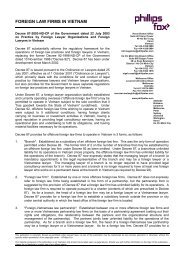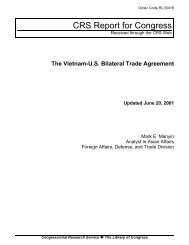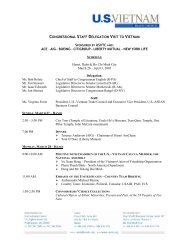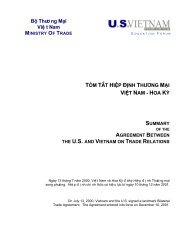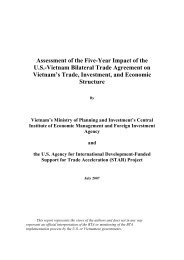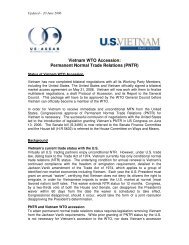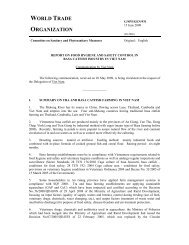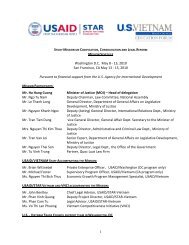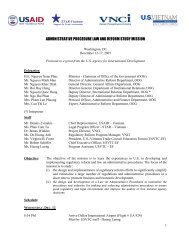Climate risks and adaptation in Asian coastal megacities: A synthesis
Climate risks and adaptation in Asian coastal megacities: A synthesis
Climate risks and adaptation in Asian coastal megacities: A synthesis
- No tags were found...
Create successful ePaper yourself
Turn your PDF publications into a flip-book with our unique Google optimized e-Paper software.
a paper commissioned by JICA (Sugiyama 2008). Asea level rise of 0.27 m by 2050 was also added tothe storm surge for the A1FI <strong>and</strong> B1 climate changescenarios based on current estimates. All these scenarios(without <strong>and</strong> with climate change effects)were then modeled to assess the impact <strong>in</strong> termsof the extent, magnitude, <strong>and</strong> duration of flood<strong>in</strong>g.Geographic <strong>and</strong>Socioeconomic ContextsThe geographic area covered <strong>in</strong> the study is theKolkata Metropolitan Area (KMA), a cont<strong>in</strong>uousurban area stretch<strong>in</strong>g along the east <strong>and</strong> west bankof the Hooghly River surrounded by some ruralareas ly<strong>in</strong>g as a r<strong>in</strong>g around the conurbation <strong>and</strong>act<strong>in</strong>g as a protective green belt. KMA has an areaof 1,851 square kilometers <strong>and</strong> consists of a complexset of adm<strong>in</strong>istrative entities compris<strong>in</strong>g 3 municipalcorporations (<strong>in</strong>clud<strong>in</strong>g Kolkata Municipal Corporation,or KMC), 38 other municipalities, 77 nonmunicipalurban towns, 16 out growths, <strong>and</strong> 445rural areas. KMC, the core of the city, lies along thetidal reaches of the Hooghly <strong>and</strong> was once mostlya wetl<strong>and</strong> area. The elevation of KMA ranges from1.5 to 11 meters above sea level (masl). The elevationof KMC area ranges from 1.5 to 9 masl with anaverage of 6 masl.With a population of about 14.7 million (<strong>in</strong>clud<strong>in</strong>g4.6 million <strong>in</strong> KMC), KMA is one of the 30 largest<strong>megacities</strong> <strong>in</strong> the world (United Nations 2007). Theaverage population density <strong>in</strong> KMA is 7,950 peopleper km 2 ; <strong>in</strong> KMC, it is 23,149 per km 2 . The averageper-capita <strong>in</strong>come <strong>in</strong> KMA <strong>in</strong> 2001–02 was $341 (at1993–94 prices).The Study AreaA special characteristic of KMA is its large slumpopulation, compris<strong>in</strong>g more than a third of the totalpopulation. These slums not only lack basic <strong>in</strong>frastructure<strong>and</strong> services, but are also the hub of many<strong>in</strong>formal manufactur<strong>in</strong>g activities, some of which <strong>in</strong>volvehighly toxic <strong>in</strong>dustries. Little oversight of suchactivities is carried out by government agencies. Thismixed residential <strong>and</strong> commercial/<strong>in</strong>dustrial l<strong>and</strong>use <strong>in</strong> slums make these areas highly vulnerable toextreme weather-related events, especially flood<strong>in</strong>g.MethodologyThe study modeled the impact of climate changeon <strong>in</strong>creased flood<strong>in</strong>g <strong>in</strong> KMA. The ma<strong>in</strong> causes offlood<strong>in</strong>g <strong>in</strong> KMA are <strong>in</strong>tense precipitation, overtopp<strong>in</strong>gof the Hooghly River due to water <strong>in</strong>flow fromlocal precipitation as well as that from the catchmentarea, <strong>and</strong> storm surge effects. L<strong>and</strong> subsidence—which occurs <strong>in</strong> a few pockets—was not <strong>in</strong>cluded<strong>in</strong> the study. The study covered three ma<strong>in</strong> sourcesthat aggravate flood<strong>in</strong>g <strong>in</strong> KMA:■■■■■■Natural factors. Natural factors <strong>in</strong>clude flattopography <strong>and</strong> low relief that cause river<strong>in</strong>eflood<strong>in</strong>g <strong>and</strong> problems with dra<strong>in</strong>age.Developmental factors. Developmental factors <strong>in</strong>cludeunplanned <strong>and</strong> unregulated urbanization;low capacity dra<strong>in</strong>age; sewerage <strong>in</strong>frastructurethat has not kept pace with the growth of thecity or dem<strong>and</strong> for services; siltation <strong>in</strong> availablechannels; obstructions caused by uncontrolledconstruction <strong>in</strong> the natural flow of storm water;<strong>and</strong> reclamation of natural dra<strong>in</strong>age areas(marshl<strong>and</strong>s).<strong>Climate</strong> change factors. <strong>Climate</strong> change factors<strong>in</strong>clude an <strong>in</strong>crease <strong>in</strong> the <strong>in</strong>tensity of ra<strong>in</strong>fall,sea level rise, <strong>and</strong> an <strong>in</strong>crease <strong>in</strong> storm surgecaused by climate change effects.Flood<strong>in</strong>g from <strong>in</strong>tense precipitation was modeledfor three scenarios—30-year, 50-year, <strong>and</strong>100-year return period flood events—assum<strong>in</strong>g noclimate change effects. The climate change effectswere added to the 100-year flood event us<strong>in</strong>g theA1FI <strong>and</strong> the B1 scenarios.Assumptions about the impacts of climatechange <strong>in</strong> Kolkata <strong>in</strong> 2050 (Sugiyama 2008) <strong>in</strong>cluded(a) a temperature <strong>in</strong>crease of 1.8°C for theA1FI scenario <strong>and</strong> 1.2°C for the B1 scenario; (b) afractional <strong>in</strong>crease <strong>in</strong> the precipitation extremes ofabout 16 percent for the A1FI <strong>and</strong> 11 percent for theB1 scenarios; <strong>and</strong> (c) sea level rise of 0.27 m by 2050,which was added to the storm surge for the A1FI<strong>and</strong> B1 climate change scenarios based on current86 | <strong>Climate</strong> Risks <strong>and</strong> Adaptation <strong>in</strong> <strong>Asian</strong> Coastal Megacities: A Synthesis Report



